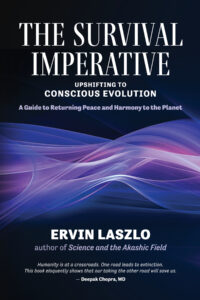There is not only a revolution in the way our consciousness works, there is also a revolution in our very understanding of the nature of consciousness. There is a new concept emerging at the cutting edge of science and philosophy, and this concept is very different from the old established concept.
Consciousness is at the same time the most familiar and the most mysterious element of our life. Consciousness is mysterious because it is not clear what it is and where it comes from. Is the flow of sensations that makes up our consciousness generated in, and confined to, our brain? Or does it extend in some way beyond our body and brain? The new concept opts for the latter. And if the new concept is true, we are not what we thought we were, and the world is not what we thought it was.
Consciousness in the new conception is more than a plaything of our imagination—it is the very substance of our beings. That of course is not the old concept, but the heart of the new one.
Here I shall suggest the basic features of the new concept, but first I outline the old idea, so as to see the differences.
The Old Idea of Consciousness
Until a few years ago, nobody other than deeply spiritual or religious people would have subscribed to the proposition that consciousness is more than a product of the workings of the brain. The accepted concept of consciousness was consistent with the physics of Newton. In the Newtonian universe, there is no place for consciousness. In the last count, all that exists in the universe are bits of matter moving in passive space and equitably flowing time. Consciousness is an epiphenomenon: something generated by real phenomena but is not real in itself.
Consciousness is like the electricity generated by a stream of electrons in a turbine. The electrons are real, the turbine is real, but the electricity generated by them is a secondary phenomenon. It disappears when the electrons cease to move in the turbine. The existence of electricity is contingent on the working of the turbine, just as the existence of consciousness is contingent on the working of the brain. After all, consciousness can no more exists in a dead brain than electric charge could exists in a stationary turbine.
We do not see, hear, or taste electricity; we know it only by the effect it produces. This is said to be the same with consciousness. We experience the flow of sensations, feelings, and intuitions we call consciousness, but we do not perceive consciousness itself. No amount of scrutiny of the brain will disclose anything we could call consciousness. We only find gray matter with networks of neurons firing in sequence, creating the flow of electrons that generates the sensations we experience. When the brain is damaged, consciousness is distorted, and when the brain stops working, consciousness ceases.
For the classical concept there is nothing mysterious, about the presence of consciousness in the universe. Human consciousness is the product of the workings of the human brain.
The New Concept of Consciousness
The turbine concept of consciousness is a hypothesis and, as other hypotheses, it can be upheld if the predictions generated by it are confirmed by observations. In this instance, the relevant prediction is that when the brain stops working, consciousness will vanish. This is confirmed by observation. People who are brain-dead do not possess consciousness.
The above claim does not admit of exceptions. We can no more account for the presence of consciousness in a dead brain than we could account for the presence of electric charge in a stationary turbine. Evidence to the contrary would place in question the basic tenet of the old concept. But evidence to the contrary does exist. It surfaces in rigorously tested experiments. There is real and credible evidence today that in some cases consciousness does not cease when brain function does.
The most widely known evidence is furnished by people who have reached the portals of death but returned to the ranks of the living. In some cases, their consciousness persists even when their brain functions are “flat.” Many temporarily brain-dead people report having had conscious experiences during their near-death episode. NDEs—near-death experiences—are surprisingly widespread: in some cases they are reported by up to 25 percent of the people who experienced a condition near physical death.
There are indications that conscious experience persists not only during the temporary cessation of brain function, but also in its permanent absence: when the individual is fully and irreversibly dead. These surprising experiences became known as ADEs: after-death experiences. The evidence for them is offered by mediums in deeply altered states of consciousness. In these trance-states they appear able to communicate with deceased persons. They “hear” the deceased recount their experiences after they have died and in some cases experience visual contact with them as well.
Reports of ADEs have been subjected to systematic scrutiny, exploring the possibility that the mediums would have invented the messages, or picked them up from living persons through some form of extrasensory perception. In a non-negligible number of cases, the theory that they were invented by the mediums or received by them in some nonordinary way could be ruled out: the messages contained surprisingly accurate information the mediums were unlikely to have accessed or invented themselves.
Given the mounting stream of evidence, we are logically obliged to accept that consciousness does not always and necessarily cease with the death of the brain that produced it. But, perhaps, the brain did not actually produce it?
The new concept claims that consciousness is more than a product of brain function. “Our” consciousness is a local and temporary manifestation of a consciousness that is an element of the real world. More and more consciousness researchers, brain scientists, psychologists, and psychiatrists uphold this concept. Consciousness could and does exist beyond the brain.
In the new concept of consciousness, the flow of sensations we call consciousness is as real as energy, frequency, amplitude, phase, and information, and more real than “matter.” The brain is not a material turbine that generates consciousness, and consciousness is not its by-product. Consciousness is a real-world phenomenon. The brain is not its generator, only its receiver and transmitter.
Consciousness exists as a real phenomenon in the universe, and this phenomenon is universal; it is “one.” Famed quantum physicist Erwin Schrödinger said that consciousness in the world does not exist in the plural: the overall number of minds in the world is one. In his last years, Carl Jung came to a similar conclusion. The psyche is not a product of the brain and is not located within the skull; it is part of the one-universe: of the unus mundus. In David Bohm’s quantum physics, the roots of consciousness are traced to the deep reality of the cosmos: the implicate order. A number of contemporary scientists, such as Henry Stapp, elaborate this concept. Consciousness, they say, is nonlocal: it is present throughout the universe.
The quantum scientists revive an ancient wisdom: We are connected through our participation in the world’s one-consciousness. This is a very different condition from being a separate entity with a separate brain producing a separate consciousness.
The new concept of consciousness is more than a theory of consciousness: it is a revolution in our understanding of being.
 ERVIN LASZLO, philosopher of science, leading systems theorist, author, co-author, or editor of more than one hundred books, was twice nominated for the Nobel Peace Prize. A celebrated child prodigy on the piano and discoverer of the Akashic Field, he is the founder and president of the international think tank The Club of Budapest and of the prestigious The Laszlo Institute of New Paradigm Research.
ERVIN LASZLO, philosopher of science, leading systems theorist, author, co-author, or editor of more than one hundred books, was twice nominated for the Nobel Peace Prize. A celebrated child prodigy on the piano and discoverer of the Akashic Field, he is the founder and president of the international think tank The Club of Budapest and of the prestigious The Laszlo Institute of New Paradigm Research.
Ervin’s newest book The Survival Imperative: Upshifting to Conscious Evolution is a guide to returning peace and harmony to the planet. With humanity facing its greatest series of simultaneous crises, Ervin Laszlo offers a scientifically based perspective on what is called for at this critical juncture of our existence: a phase of upshift to higher levels of order and coherence to keep us on our evolutionary path.








